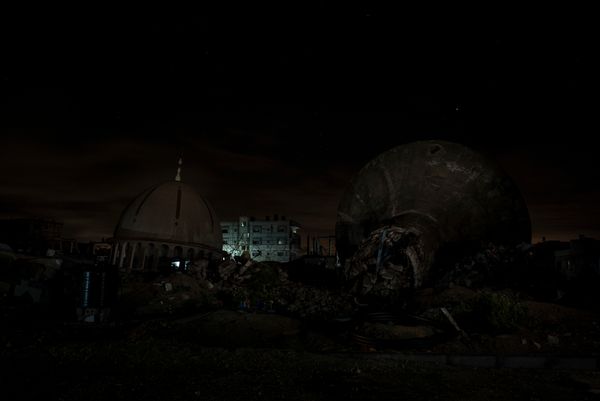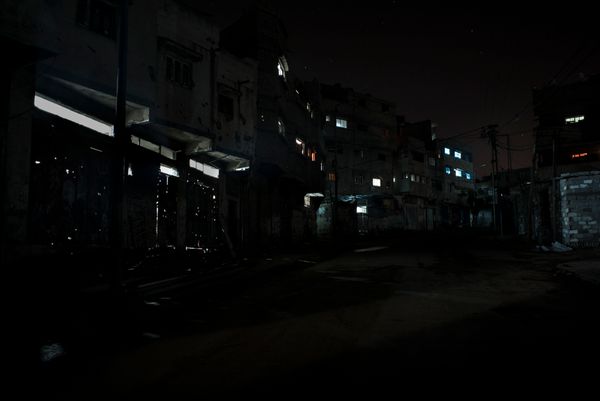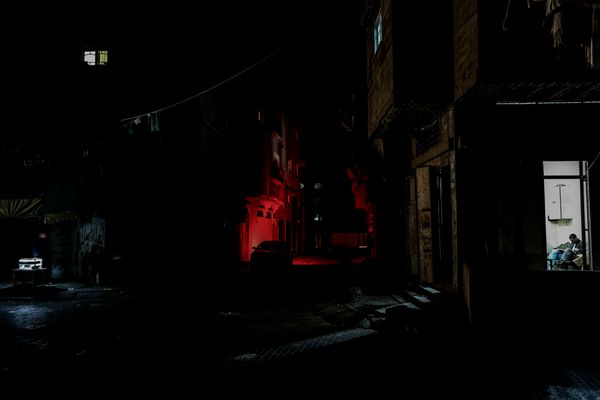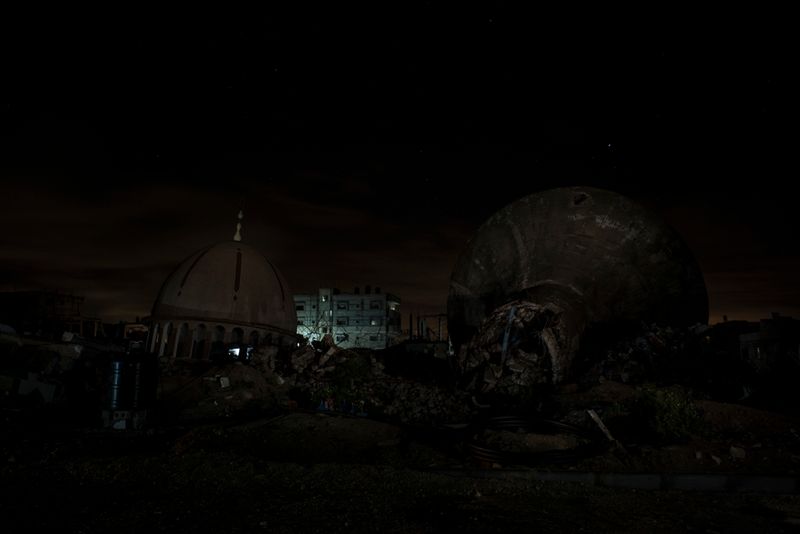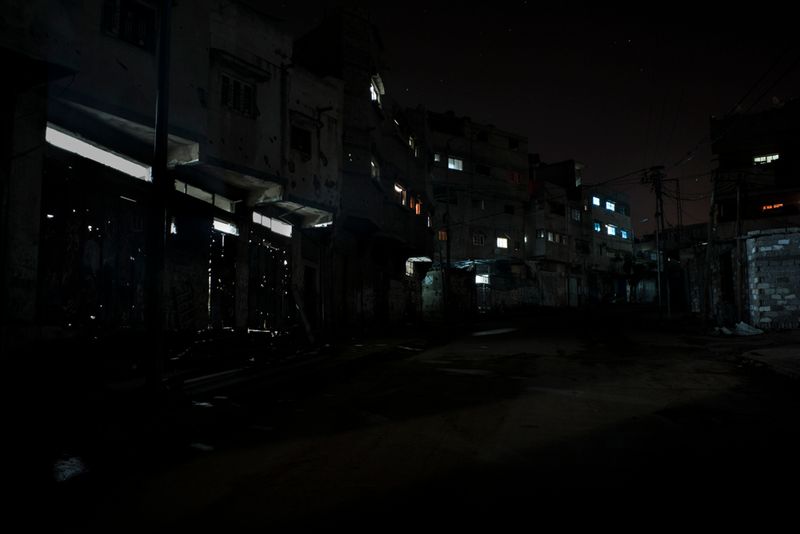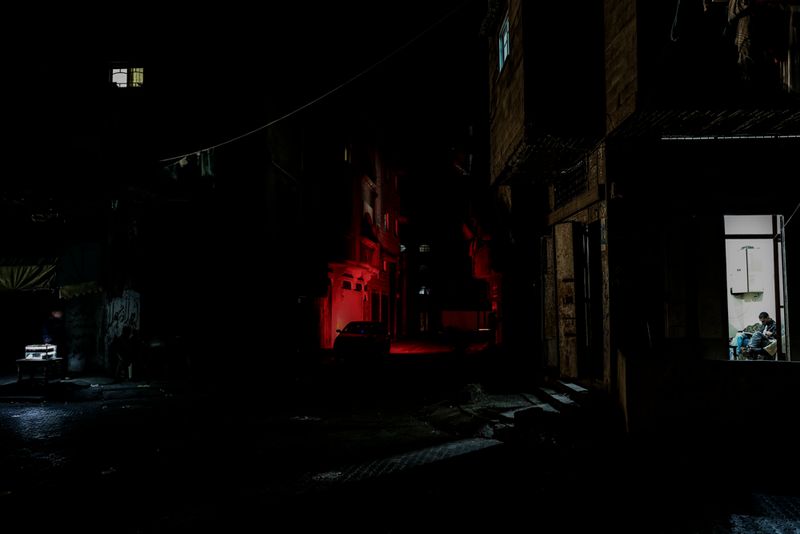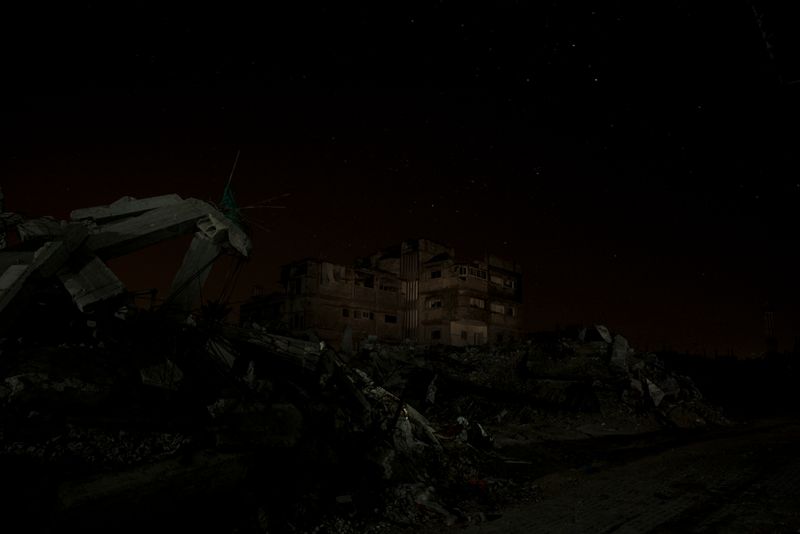Gaza BlackOut
-
Published24 Aug 2016
-
Author
"By definition, the dark can not be photographed. This represented a very interesting challenge for me" - Gianluca Panella
"By definition, the dark can not be photographed. This represented a very interesting challenge for me" - Gianluca Panella
© Gianluca Panella, from the series Gaza BlackOut
Gianluca Panella is an independent visual journalist focused on social reportage, current affairs, and portraits. He has worked in the Balkans, Egypt, Haiti, Israel and Palestinian Territories, Gaza, Lebanon, Morocco, the United States and Europe. His photography has been featured in a variety of Italian and international publications.
From 2007 to 2012, Panella collaborated with the Massimo Sestina News Agency, producing work for the Italian press. Since 2012, he has dedicated his time to personal projects and his work has been awarded by the World Press Photo in the General News Stories and shortlisted at the Amnesty International Press Awards.
How did you start on your Gaza BlackOut project?
I started working on Gaza BlackOut in December 2013. I was in the Gaza strip to work on “Behind The Lathmeh”, a long story about the human side and the family life of the fighters of the Palestinian resistance - a part of my long term project “State of Captivity” about the siege in the Strip. It was a particularly hard time because of the very bad weather and the closing of Rafah’s border. The Blackouts in Gaza are very frequent and they don't represent news anymore. But that December, the closing of the borders caused a shortage of fuel from Egypt, so the prices of the fuel from Israel drastically levitated and a big flood (the worst in 20 years) damaged a lot of already crumbling infrastructures.
Due to the entanglement of these events, the electric energy was drastically rationed - in certain areas there was up to 20 hours without electricity. At that point the blackouts became newsworthy. Photographers began to cover the exceptional blackouts and the agencies came out with images of silhouettes walking in the street, people living in houses illuminated by candles, landscapes of the city fallen into darkness…But, I didn't see photos that really made me feel the serious hardship that people - and us as well - were facing living in darkness at night and without electric devices at day time. When I shoot, my aim is to try to make whoever looks at the photo empathize as much as possible with the subject. I try to make sure that the viewer will start asking questions to himself, to find out more because he feels personally involved, because he identifies with what he sees. So I started thinking about how to achieve that goal in that situation. Needless to say that, by definition, the dark can not be photographed. This represented a very interesting challenge for me.
© Gianluca Panella, from the series Gaza BlackOut
Your work is unlike anything that has come out of Gaza. How did you end up using a landscape approach?
Thank you. It’s just what I wanted to hear. I want to say that during the creative process, I was not focused on producing different images - that is implicit in my work. I think that a good photographer should always try to take several images to arouse interest - but I was focused on how I could give back that feeling of helplessness and insecurity that you feel by moving in the darkness. Washing, eating, walking, living in the obscurity for so many hours every day. But I did not want to portray a ghost town. Gaza at night may seem like a ghost town, but it’s not at all. We’re talking about almost 1.8 millions inhabitants in an area of 360 km2. A very high density of population. If we want to think about the strip as a country, we should think about the p.d. of Bangladesh. If we want to think about Gaza as a city, we should compare it with the p.d. of a metropolis like Chicago.
I wanted to portray a crowded city immobilized by the darkness. I decided that I would do the landscapes to portray glimpses of everyday life otherwise incomprehensible for those who take for granted the right that humans should have to a supply of energy. Regarding the technical aspect of the work, I used a tripod to be able to open the shutter for a long exposure. The exposure was measured for the few light sources that I had chosen to include in the frame, then the rest of the frame, with no light sources, would have been completely dark. To be able to see the landscape (because the human eye always sees something even in the dark), I used a light painting technique that is typically used in still life photography. And in those sensitive neighborhoods, at night, life is literally still! I used a small but very powerful torch, that I always carry with me, and I gently "brushed" the areas that I wanted to show, lighting the torch for a few seconds, moving very quickly from an area to the other or lurking somewhere out of the frame to illuminate a certain area or a certain building or tree. Meanwhile, my fixer and good friend Aysar was counting aloud the seconds ticking. Apart from the intense cold, the exceptional rainfall, when we could work undisturbed by Hamas guys, it was also fun.
© Gianluca Panella, from the series Gaza BlackOut
Do you know what the response of the project in Gaza was outside the awards?
I don’t really know. I remember that NewsWeek Japan called me to buy some pictures and they made a very beautiful publication - they really cared about the story and the print. All black…white fonts…nice! After the WPP award I felt very devoted to Gaza’s situation and I worked very hard for the following year on my long term project. I didn’t have the time and the intention to “push” the work in a commercial way.
Then in July 2014 IDF (Israeli Defense Forces) started the operation Protective Edge and it became one of the toughest wars in Gaza; it was a very long time that IDF didn’t organize a ground invasion inside the Strip - more than 2000 victims weren’t counted since the second intifada. After covering the war I decided to go back into the strip in the winter of 2015 and 2016 and of course after 2 years their conditions and the blackouts were the same. So I decided to continue the work shooting the aftermath. I’d like to have the opportunity to make a very good exhibition to show this work in the right way. Canon printed several of the WPP exhibitions around the world in a very bad way, you couldn’t see anything in the dark areas of the frame, but my work is interesting because of the dark areas that are full of details; (the files are made by a CCD sensor). So if you don’t print Gaza BlackOut in the proper way, you’ll never appreciate the work: that’s why I’m very interested in finding someone that will be able to produce a good exhibition with quality prints.
© Gianluca Panella, from the series Gaza BlackOut
You come from a background working with a news agency. How did you develop, then, your own personal style in photography?
Working, questioning myself, studying over and over again… Sometimes it has been very useful to talk with some very good editors. I developed my personal style only when I really felt I needed to do it. When I quit my agency, in 2011, I really couldn’t do anything else other than search for myself as a photographer. It has been a very long and tough journey. I come from the “school” of newspapers, of crime reporting…the police station every morning, it was a totally different field of work. You didn’t have the time to think about what you were feeling as a photographer, which could be the best way to send the message, or how to comunicate that news…No time to empathize with your subjects.
All of this was going to be too heavy for me. I think that you can develop your personal style only when and if you have something to say. If you really care about your topic and your message, if you really believe that the story needs to be told. There are many trends in photography created by editors and curators to build their own market. This drives many photographers out of focus: they spend their energies trying to reproduce a style that is successful in that moment, but in the end, they are not doing their own photography.
Would you say your personal work remains linked to the news?
Of course. This is exactly the point. My aim is to cover stories between the wrinkles of the big events that big networks cover so badly and lightly. That’s why I don’t ask for assignments very often.
© Gianluca Panella, from the series Gaza BlackOut
What were the biggest challenges you faced in Gaza while shooting Gaza BlackOut?
Like I was saying before, the “photographic challenge” was to shoot the darkness. We know that photography means “writing with light”, so I found that a very fascinating concept. But the real heavy challenge was to be stopped 5-6 times per night by Hamas police, Al Qassam or Islamic Jihad fighters and once or twice (per night) we were detained for hours. At that point the night was over; sometimes I went back home with one, maybe two pics in a full night.
In 2015 secret services stopped us immediately because we were very close to a tunnel’s entrance and very close to the Israeli border. They detained us for the entire night and they stopped my fixer’s driving license for a few days. We stayed in a small, completely bombed, secret office, in the middle of the buffer zone all night. The chief was sleeping at home of course, so they couldn’t talk to him to understand if we could go. We drank a lot of tea, talking a lot about politics until they let us to go early in the morning. Not even one photo that night!
In Gaza, at night, even young guys sympathizing with Hamas could stop you and try to create problems. You need a very clever fixer to work with at night, especially if you’re a foreigner with a tripod, walking and jumping around flash lighting mosques and buildings in very sensitive neighborhoods, with someone screaming the seconds remaining before the closing of the shutter! I have to say that lately when we are stopped or detained they let us free very soon because some of them know about my work now.
To learn more about this project, visit Gianluca's PHmuseum profile.
